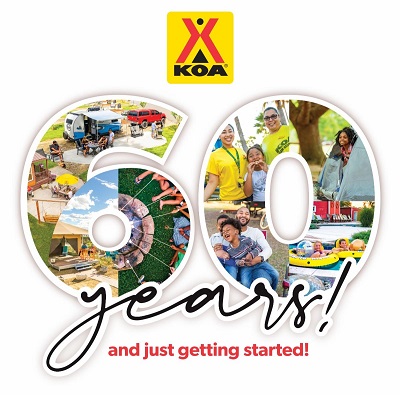
Kampgrounds of America, Inc. (KOA) has released its annual North American Camping Report, measuring the continued explosive growth of U.S. and Canadian camping.
A record 57 million households flocked to the outdoors in 2021, the report said. The report reveals that camping accounts for 40% of leisure traveling trips and campers are booking earlier than ever for the year ahead.
RVing is continuing to boom as a past-time; the report shows:
- RVing is at an all-time high, with 11 million RV owners camping last year, and two million new RV renters in 2021.
- There is a marked increase in peer-to-peer RV services, with seven-in-10 non-RVers saying they are likely to rent from a peer-to-peer service, including 79% of millennial respondents.
Glamping and RVing also continue to grow in popularity. Nearly half of new campers in 2021 went glamping at least once, and almost 15 million households went RVing at least once to explore the outdoors.
While in the past, most RVers rented or borrowed RVs for their vacations, 77% of RVers now own their own RV. Similarly, interest in RV purchasing is high among non-RV owners, with 32% saying they want to purchase an RV in 2022.
There were over 9.1 million first-time campers last year. According to the report, the pandemic accelerated sustained interest in camping during the past two years, welcoming millions of new and returning campers year-over-year.
Camping is of primary importance in the hospitality industry, the report said. Tracking eight years of continued growth and interest in camping, and the pandemic fueling a swell in new campers, the 2022 survey found that camping has become a mainstream, widely adopted leisure travel option. Not only did 40% of leisure trips result in camping, but 80% of all leisure travelers choose camping or glamping for at least some of their trips.
“Our research shows that camping is one of the primary ways households prefer to travel and spend their leisure time because 75% of campers say it reduces stress and contributes to their emotional well-being,” said Whitney Scott, chief marketing officer of Kampgrounds of America. “Camping is driving leisure travel’s recovery and its benefits will fuel future market share.”
This growth has resulted in campers booking their campsites much earlier in the season, with about 75% having already booked at least some of their campsites for 2022 by early April. In terms of camping behavior, 46% of campers worked remotely during at least some of their trips, up from 41% in 2020, including 57% of millennials.
Since KOA’s first North American Camping Report was published in 2015, the number of camping households in the U.S. and Canada has increased by 77%.
Although camping grew steadily from 2014 to 2019, the industry witnessed a 31% increase in people camping at least once a year over five years and grew by 36% in just the past two years.
In 2021, 57 million households reported that they went on at least one camping trip last year, an 18% increase compared to 2020 and the most significant year-over-year change since the report’s inception. Among all North Americans polled, nearly half (48%) participate in both camping and another form of leisure travel, while about 1-in-20 households camp exclusively as their only form of leisure travel.
The report also found that remote work is here to stay.
As the pandemic has created permanent ripple effects in the way Americans work, this shift is also having an impact on the camping industry. A total of 46% of campers work during at least some of their trips, up from 41% in 2020, including 57% of millennials.
Close to half of campers rated having Wi-Fi as important. Having Wi-Fi available affects their ability to camp so they can extend their trips and stay connected to work as needed.
Diversity, equity and inclusion in the outdoors continues to be important. New campers continue to be more diverse when compared to campers overall, with 54% of new campers self-identifying as non-white. Currently, about one out of every three camper households includes people who identify as Hispanic, Black, Asian, or other non-white ethnicities. A quarter of Black campers plan to embark on their first solo camping trip in 2022.
The age demographic makeup of campers continues to trend younger, with millennials and Gen-Z making up 53% of all campers. Seven-in-10 new campers are 40 or younger.
In 2021, it is estimated that campers spent about $44 billion in local communities during their trips.
The results of the report are taken from the KOA 2022 North American Camper Survey and based on a total of 4,145 surveys completed from a random sample of 2,945 U.S. households and 1,200 Canadian households.
Celebrating 60 years in 2022, KOA has 26 new franchise locations in Virginia, California, Alabama, Nebraska, Oregon and Alberta as well as a new corporate headquarters in the organization’s hometown of Billings, Montana.
View additional findings from the 2022 North American Camping Report, or view previous versions of the annual report.




